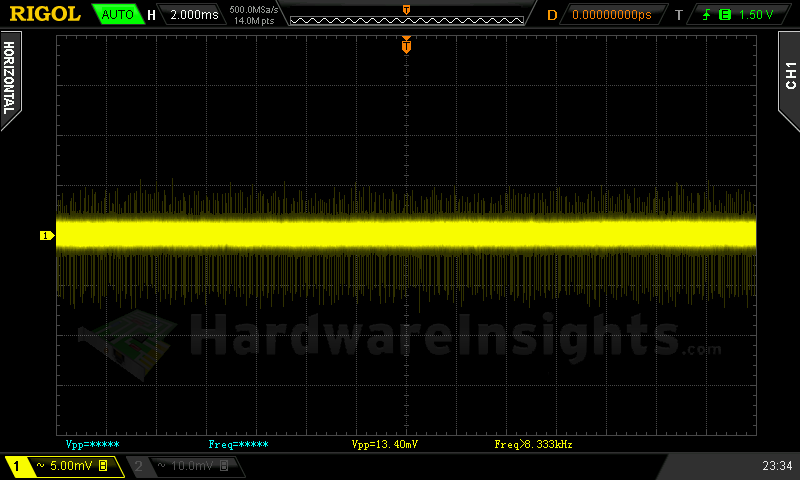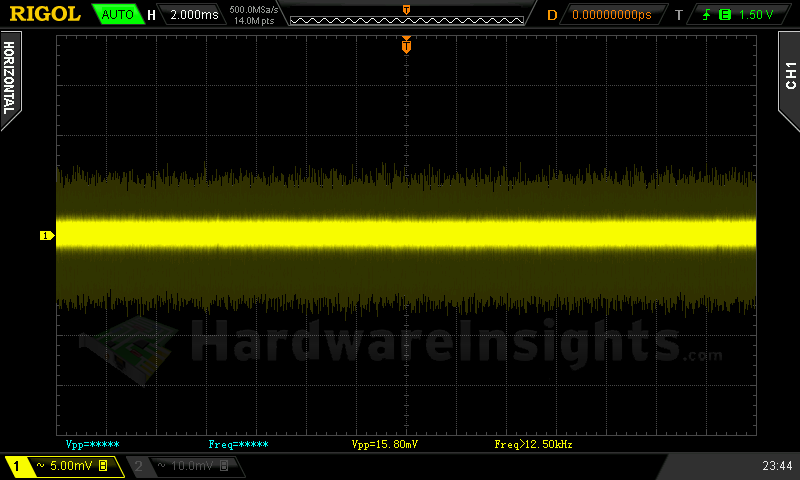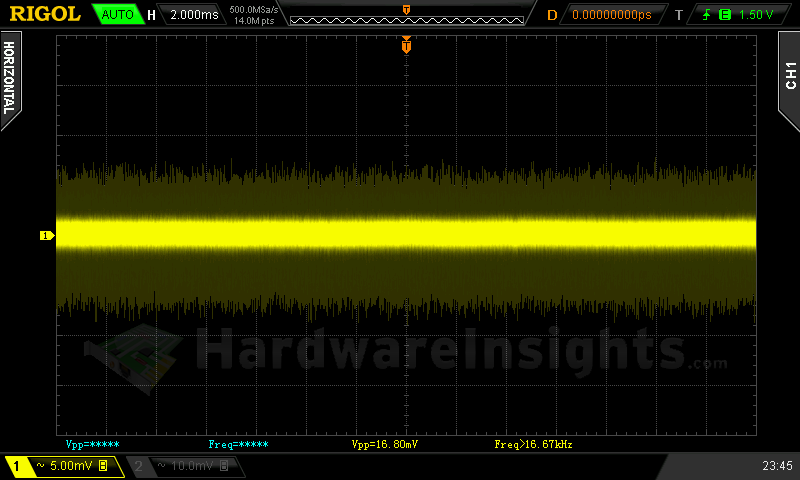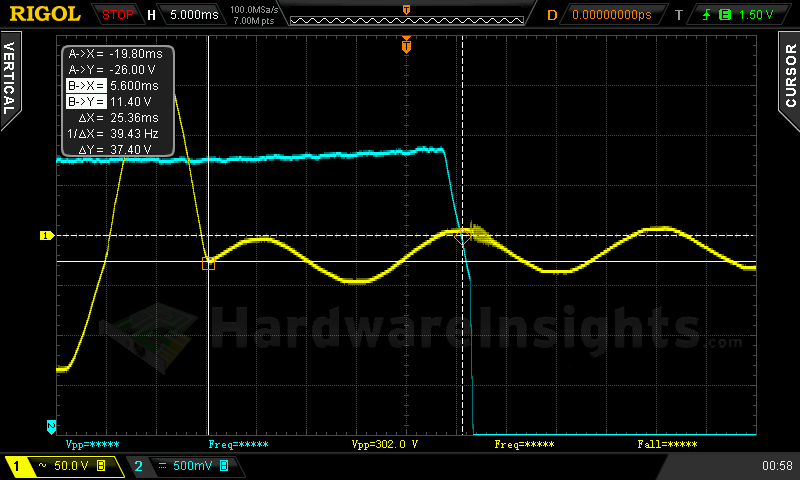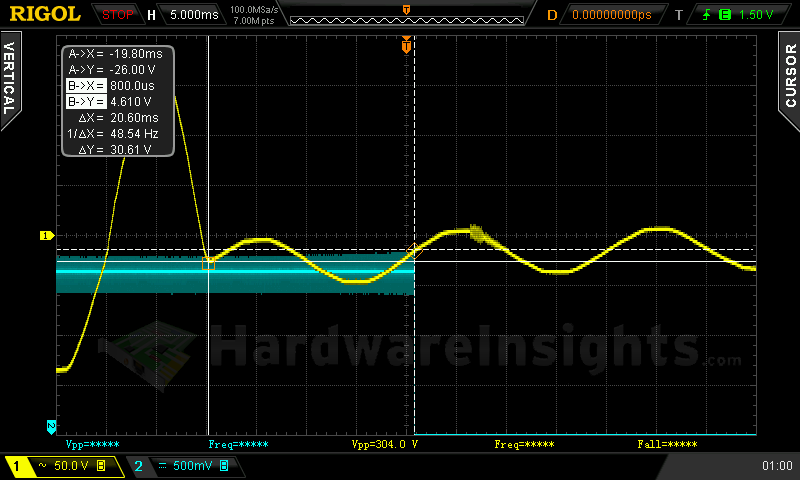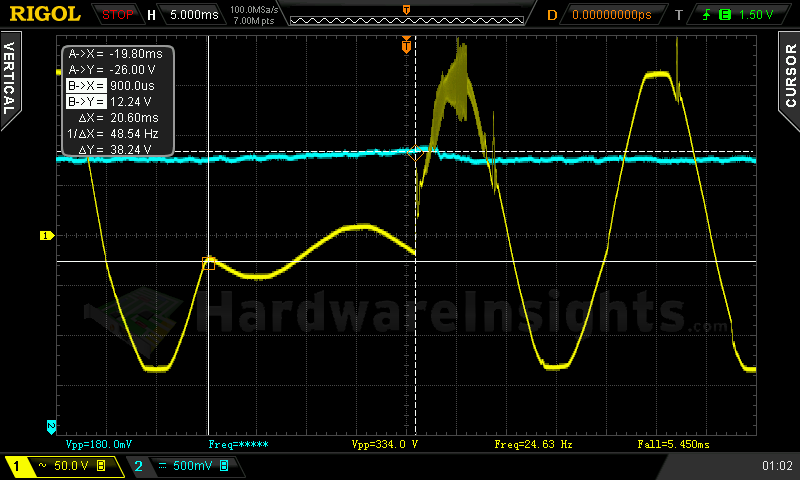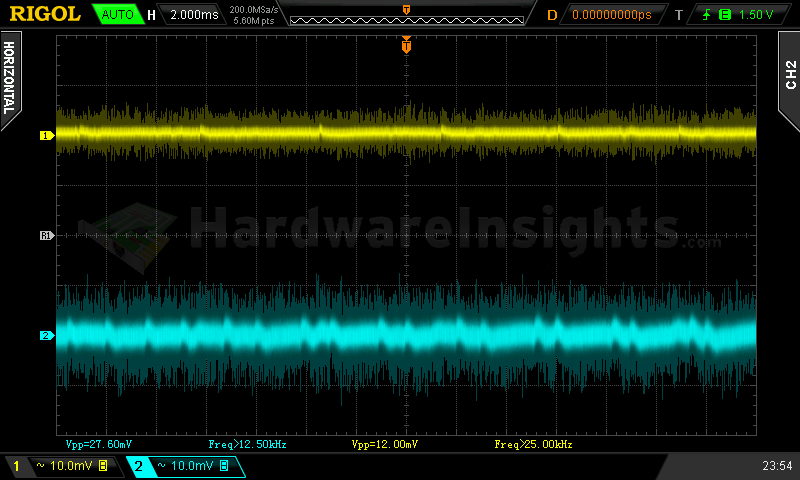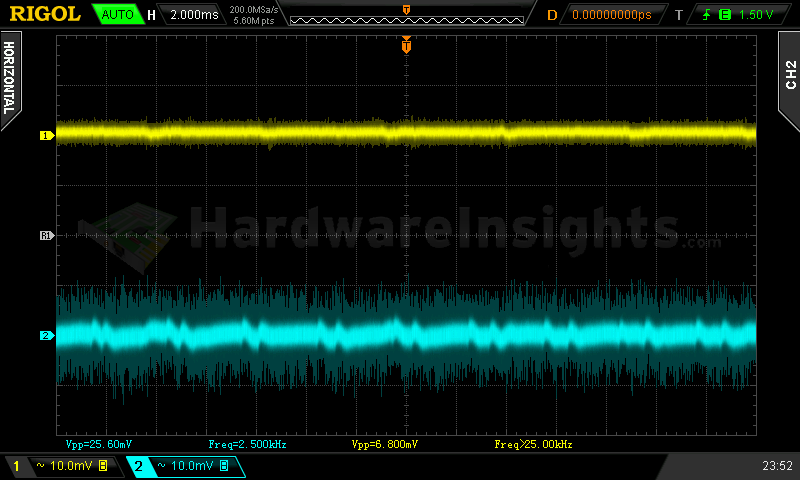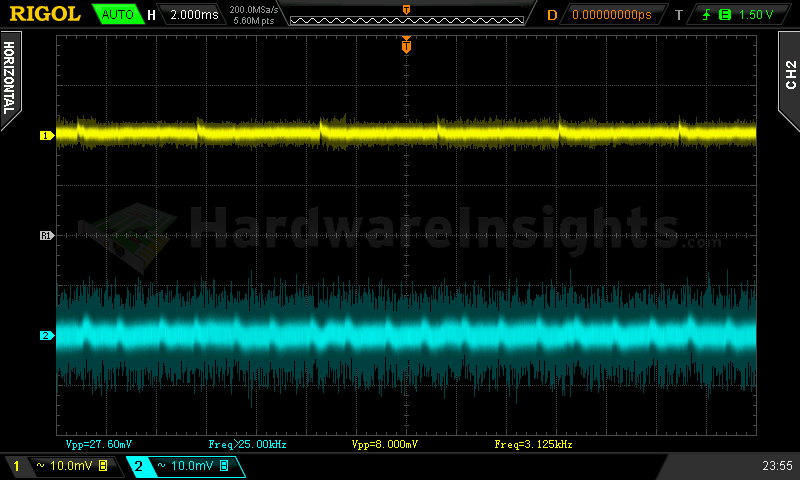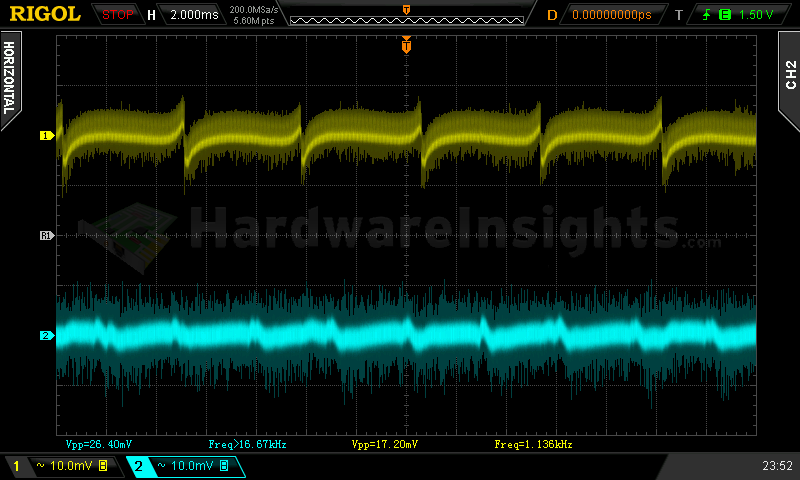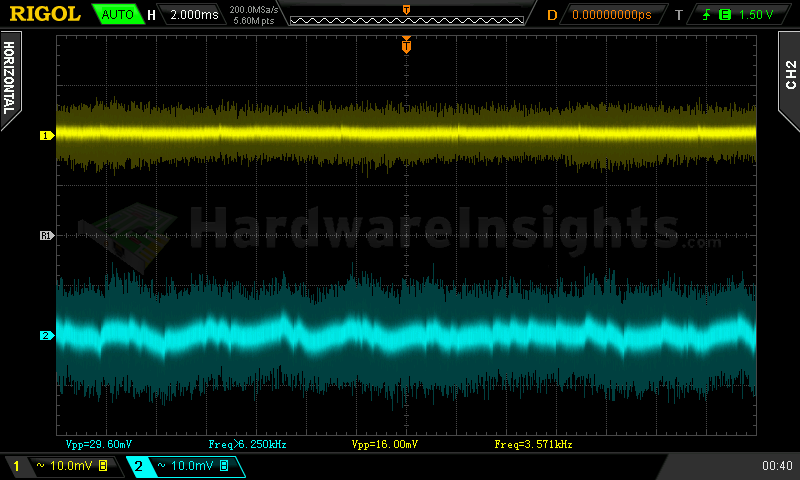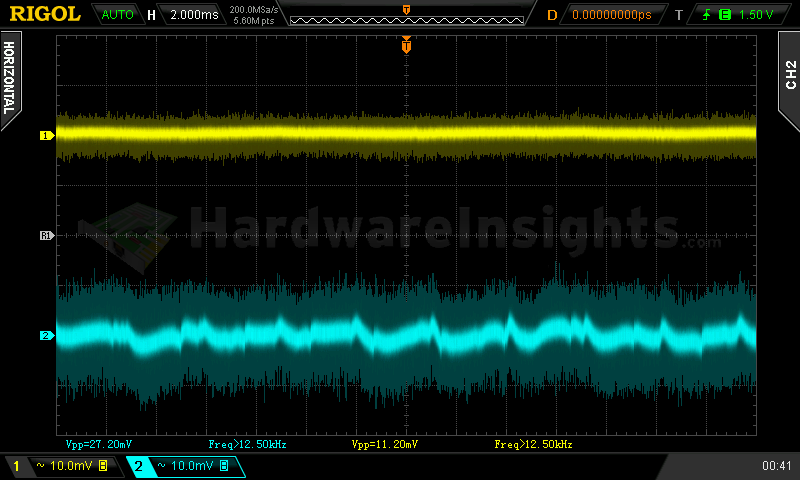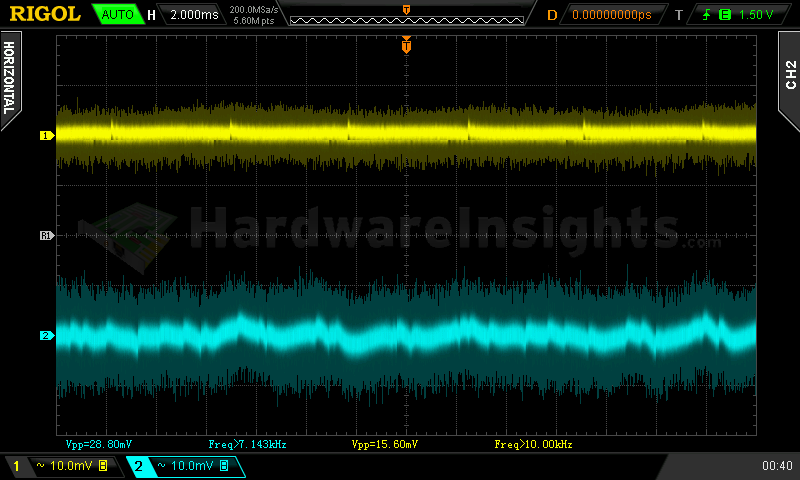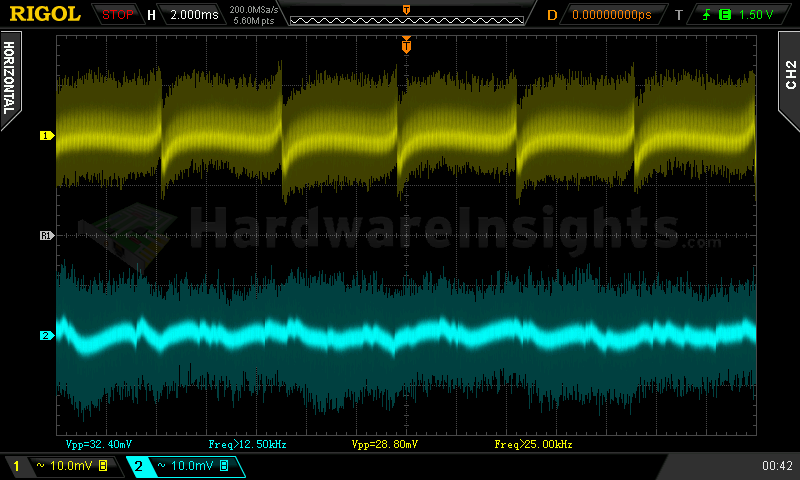Contents
- 1Introducing the Be Quiet! Straight Power 10 700 W CM (E10-CM-700W)
- 1.1Packaging and accessories
- 2Connectors & cabling
- 2.1Casing & cooling
- 3Input filtering
- 4Primary side
- 4.1+5 V stand-by rail
- 5Secondary side
- 5.1Build quality
- 6Load testing
- 6.1Loading +5 V SB
- 6.2Hold-up time
- 6.3Combined loading
- 6.4Combined loading ripple
- 6.5Crossloading, overloading
- 6.6Crossloading, overloading ripple
- 6.7Fan speed, temperatures and noise
- 7Conclusion and evaluation
- 7.1Thanks
- 7.2Discussion
Load testing
Loading +5 V SB
As always, all load testing is performed per our testing methodology. The voltage regulation is quite decent, as the E10-CM-700W maintains regulation within 2%, which is nice. The ripple is slightly higher though and the efficiency is only just average.
| Output (W) | Load (A) | Voltage (V)/ ripple (mV) | Input (W) | Efficiency/power factor |
| 0 | 0 | 5.08/13.40 | 0 | —/0.003 |
| 14.17 | 2.87 | 4.93/15.80 | 19.07 | 74.3 %/0.490 |
| 16.48 | 3.36 | 4.91/16.80 | 22.18 | 74.3 %/0.515 |
+5 V SB ripple (left to right): 0 A; 2.87 A; 3.36 A
Hold-up time
As we can see on the oscilloscope screenshot, the hold-up time of the E10-CM-700W +12 V rail is relatively quite long at 25.36 ms. Most of the Aurum and Aurum-derived platforms I measured so far performed good here and the E10 CM is no exception.
The hold-up time of the power good signal is a bit shorter, at 20.60 ms.
While interrupting the power for a given time, I found the +12V rail hardly noticed the drop. Nice results indeed.
Combined loading
Combined loading was quite good. Finally, for perhaps the first time while measuring an FSP unit, we finally get a good result here! So despite it not having DC-DC modules, the regulation is still implemented in a way where it produces good results. We are finally within 2% regulation (both line and load). What’s more, the -12V rail also has outstanding regulation, at least compared to many competing units out there.
| Output power | Load/ voltage +5 V SB | Load/ voltage +3.3 V | Load/ voltage +5 V | Load/ voltage +12 V | Load/ voltage −12 V | Input power | Efficiency/ power factor |
| 4.1 %/ 29.04 W | 0 A/ 5.06 V | 0.006 A/ 3.36 V | 0.399 A/ 5.05 V | 1.833 A/ 12.17 V | 0.395 A/ −11.91 V | 42.70 W | 68.0 %/ 0.761 |
| 20 %/ 134.07 W | 0.533 A/ 5.04 V | 1.486 A/ 3.35 V | 2.298 A/ 5.04 V | 9.06 A/ 12.16 V | 0.390 A/ −11.92 V | 156.6 W | 85.6 %/ 0.947 |
| 40 %/ 273.26 W | 1.02 A/ 5.02 V | 3.08 A/ 3.33 V | 4.91 A/ 5.03 V | 18.83 A/ 12.14 V | 0.384 A/ −11.94 V | 308.8 W | 88.6 %/ 0.982 |
| 60 %/ 423.18 W | 1.89 A/ 4.99 V | 5.95 A/ 3.32 V | 5.85 A/ 5.02 V | 29.7 A/ 12.12 V | 0.391 A/ 11.96 V | 482.2 W | 87.8 %/ 0.992 |
|
80 %/ 552.38 |
2.36 A/ 4.99 V | 7.27 A/ 3.32 V | 7.87 A/ 5.02 V | 39.0 A/ 12.11 V | 0.389 A/ −11.98 V | 629.7 W | 87.7 %/ 0.995 |
| 100 %/ 697.8 W | 2.86 A/ 4.98 V | 11.31 A/ 3.32 V | 9.16 A/ 5.02 V | 49.2 A/ 12.10 V | 0.394 A/ −11.99 V | 797.9 W | 87.5 %/ 0.996 |
As for the efficiency, the unit seems to pass 80 PLUS Gold, considering that I’m taking into account the usual variation in the results of this test that my equipment produces. Though I can clearly state that at low loads, the efficiency is not really that good.
Combined loading ripple
The ripple values are also very nice. The minor positive rails even managed to keep ripple within 20 mV, that’s very nice indeed. All the measurements are within 40 % of the allowed interval, that is good.
| Output % | Ripple +5 V SB | Ripple +3.3 V | Ripple +5 V | Ripple +12 V | Ripple −12 V |
| 4.1 | 12.00 mV | 6.800 mV | 8.000 mV | 27.60 mV | 17.20 mV |
| 20 | 14.00 mV | 9.200 mV | 7.200 mV | 28.00 mV | 14.40 mV |
| 40 | 12.00 mV | 10.80 mV | 8.400 mV | 24.00 mV | 20.00 mV |
| 60 | 16.40 mV | 13.20 mV | 9.200 mV | 24.80 mV | 18.40 mV |
| 80 | 10.80 mV | 8.800 mV | 12.00 mV | 27.60 mV | 19.20 mV |
| 100 | 16.60 mV | 11.20 mV | 15.60 mV | 32.40 mV | 28.80 mV |
Ripple 4.1% load (left to right): +5 V SB; +3.3 V; +5 V; −12 V. The second channel is connected to +12 V.
Ripple 100% load (left to right): +5 V SB; +3.3 V; +5 V; −12 V. The second channel is connected to +12 V.
Crossloading, overloading
Crossloading tests went fine. So the results for this test clearly shows that this platform really is more advanced than the standard Aurum. The voltage regulation was mostly the same as it was under combined loading. Efficiency dropped further, even under 80 % with a crossload of the minor rails. I tried overloading two of the +12V rails and the unit mostly turned off between 33 and 35 A. The +5 V or +3.3V rail OCP limit was not reached. The overtemperature protection is also working as it kicked in after 2:42 at full load with a simulated stuck fan.
| Output power | Load/ voltage +5 V SB | Load/ voltage +3.3 V | Load/ voltage +5 V | Load/ voltage +12 V | Load/ voltage −12 V | Input power | Efficiency/ power factor |
| 16 %/ 109.85 W | 0.538 A/ 5.02 V | 23.6 A/ 3.33 V | 0.361 A/ 5.03 V | 1.827 A/ 12.15 V | 0.380 A/ −11.96 V | 143.5 W | 76.6 %/ 0.939 |
| 22 %/ 157.19 W | 0.544 A/ 5.11 V | 1.492 A/ 3.33 | 24.6 A/ 5.00 V | 1.812 A/ 12.15 V | 0.391 A/ −11.98 V | 197.7 W | 79.5 %/ 0.961 |
| 98 %/ 683.57 W | 0.536 A/ 5.03 V | 1.476 A/ 3.34 V | 0.403 A/ 5.04 V | 55.3 A/ 12.10 V | 0.401 A/ −12.00 V | 781.4 W | 87.5 %/ 0.996 |
| 122 %/ 856.13 W | 3.36 A/ 4.96 V | 10.41 A/ 3.31 V | 12.18 A/ 5.02 V | 62.9 A/ 11.75 V | 0.401 A/ −12.00 V | 987.4 W | 86.7 %/ 0.997 |
However, as with the Aurum, the OPP is not properly implemented. Instead there is power limiting again which resulted in maximum power output of about 850 W. Afterwards, with each increase of the power draw, the voltage dropped significantly. The unit finally turned off when the voltage on the +12v rail(s) dropped under 10.9 V which I do not consider as properly functioning UVP either. So while there are some enhancements here, many serious flaws still remain.
Crossloading, overloading ripple
Here the ripple was similar to that of the combined loading set of tests. Though the stand-by rail crossed the 40% barrier once.
| Output % | Ripple +5 V SB | Ripple +3.3 V | Ripple +5 V | Ripple +12 V | Ripple −12 V |
| 16 | 16.00 mV | 4.000 mV | 14.80 mV | 16.00 mV | 23.60 mV |
| 22 | 23.60 mV | 5.200 mV | 16.80 mV | 16.00 mV | 20.00 mV |
| 98 | 15.60 mV | 14.40 mV | 20.00 mV | 24.80 mV | 20.40 mV |
| 122 | — | — | 28.00 mV | 18.80 mV | — |
Fan speed, temperatures and noise
The fan inside the Be Quiet! E10-CM-700W started spinning right away. During the first three tests, it was only barely running though at just less than 300 RPM. But then the speed increased quickly to over 700, 1000 and finally to what seemed like its maximum speed – over 1500 RPM. But by now, and as expected, there was somewhat higher of an ambient noise, but I can state that even at over 700 RPM the fan is still basically inaudible. At 1000 RPM you can really start to hear it, and soon enough at even higher speeds it gets pretty loud. But consider that this unit does afterall have a 135mm fan, so it’s reasonable to expect that at over 1500RPM it will get quite noisy.
| Output % | Fan speed (RPM) | Temperature intake/ outtake | Noise (dBA) |
| 4.1 | 265 | 26 °C/ 33 °C | 39.9 |
| 20 | 266 | 26 °C/ 35 °C | 39.9 |
| 40 | 268 | 26 °C/ 43 °C | 39.9 |
| 60 | 738 | 27 °C/ 40 °C | 39.9 |
| 80 | 1067 | 27 °C/ 41 °C | 40.1 |
| 100 | 1540 | 26 °C/ 42 °C | 42.5 |
| CL 16 | 515 | 25 °C/ 38 °C | 39.9 |
| CL 22 | 548 | 25 °C/ 37 °C | 39.9 |
| CL 98 | 1435 | 27 °C/ 43 °C | 41.7 |
| OL 122 | 1548 | 28 °C/ 48 °C | 42,5 |
After the OTP testing the temperature of the exhaust air measured at over 46 °C and the fan was running at 1550 RPM. It indeed seems that the maximum speed is only 1550, and not 1800 RPM. In my opinion this is a good thing because otherwise it would run even faster and louder. The unit is rather efficient, but still with 700 W of nominal power it produces some considerable amount of waste heat. With the way the fan controller is setup, this unit can theoretically run quite warm in many scenarios. This is especially true when you consider that at slightly less than 50% load the fan spins very slowly. Combined with the garbage capacitors this can lead to a less than desirable environment. You should perhaps only rely on this unit within the 5 year warranty, but after that, who knows what’s going to happen.
